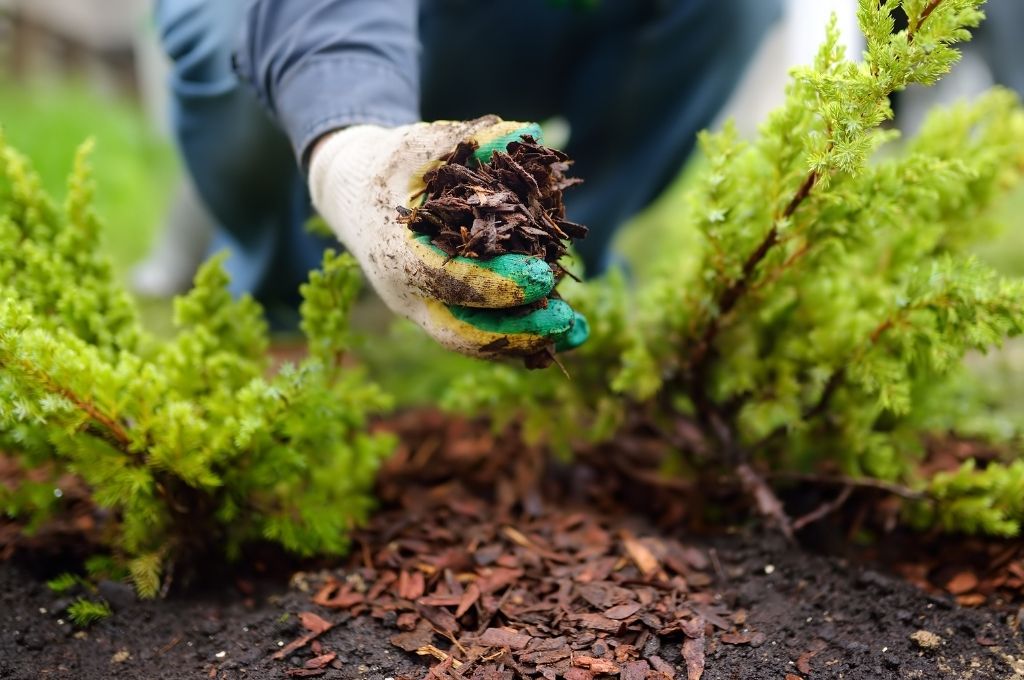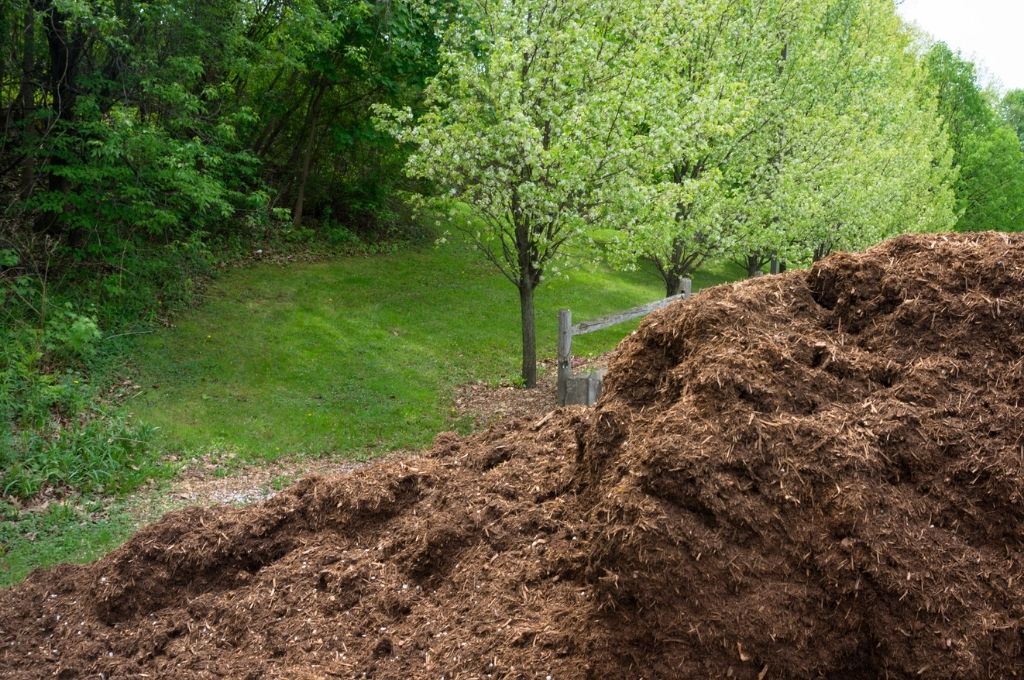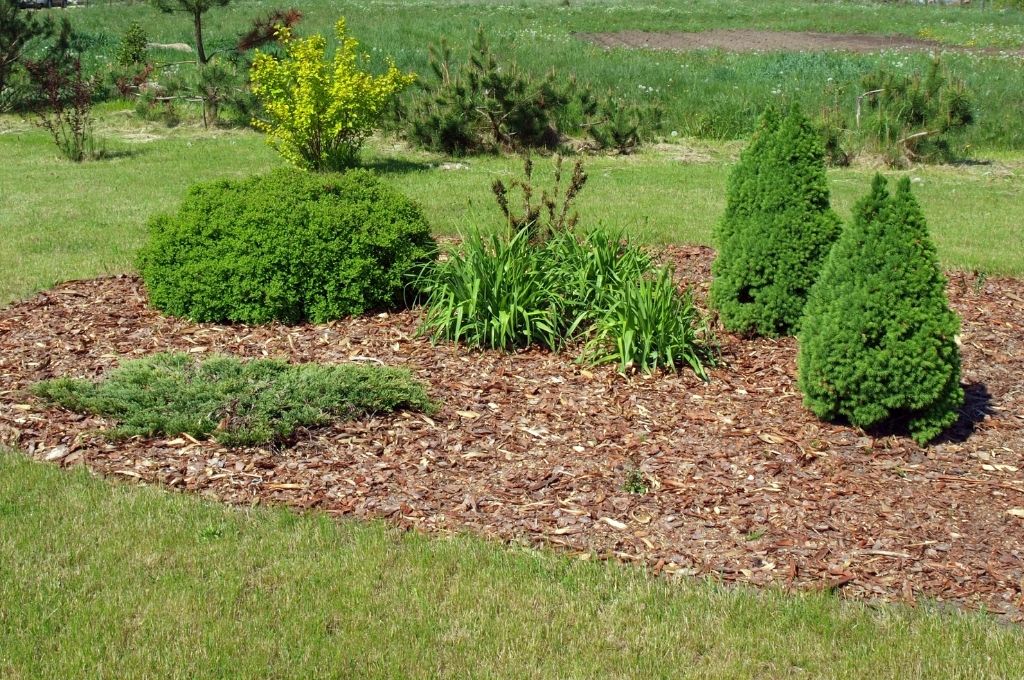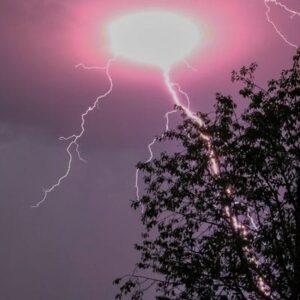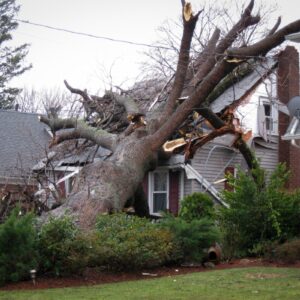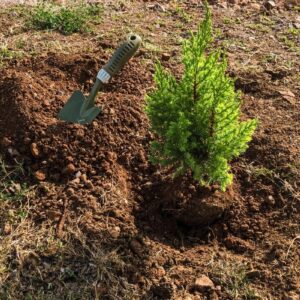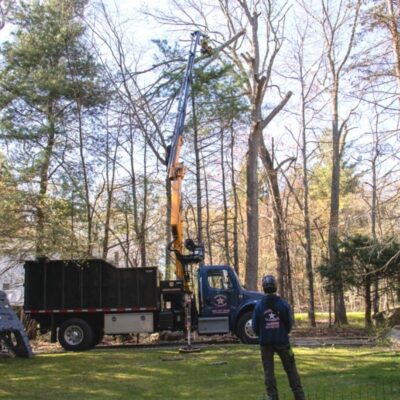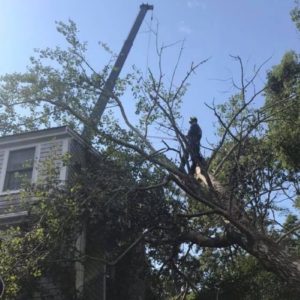We see it all the time – fresh mulch piled high around trees like tidy little volcanoes. It may look fine, but that approach is damaging the root flare, trapping moisture, and inviting rot.
Mulching is more than just dumping wood chips from a bag and calling it a day. If your goal is long-term tree health, there’s a better, proven way to mulch around trees that supports growth, protects roots, and helps your landscape thrive.
Key Takeaways:
- Organic mulch adds nutrients to the soil as it breaks down, improving its structure and fertility and promoting better tree growth and moisture retention.
- Mulch protects soil from erosion and compaction, which is especially important in the MetroWest area’s sandy loam soil, which is prone to compaction.
- Each season offers different benefits from mulch: winter insulation for roots, spring weed suppression, summer moisture retention during heat and drought, and fall protection for new plantings.
- When applying mulch, maintain a 2-4–inch layer and avoid “mulch volcanoes” by keeping mulch away from tree trunks.
- While mulch provides numerous benefits for trees, it should be part of a comprehensive tree care approach that includes proper pruning.
Why Mulch Around Trees?
Mulching around trees helps protects roots, improve soil health, and support long-term tree growth. Whether you’re caring for a newly planted tree or maintaining a mature one, proper mulching creates the conditions trees need to stay healthy, strong, and resilient year after year.
Here’s how mulch works – and why it’s one of the best things you can do for your landscape.
Mulch Adds Soil Nutrients
“The soil around here’s actually pretty decent, but it doesn’t stay that way forever. As your trees grow, they pull nutrients out of the ground, and if you’re not putting anything back, the soil eventually runs out of what they need. That’s why we recommend using wood chips – they break down over time and give the soil a steady supply of what trees need to stay healthy.” – Rich Yurewicz, Owner of American Climbers
As wood chips break down, their organic matter becomes part of the soil. Tiny particles of nutrients bond to the soil, improving its structure and fertility. Healthy soil with plenty of organic matter supports vigorous tree growth and holds more moisture for longer.
Granular or liquid fertilizers are helpful when your trees need immediate nutrients, but these fertilizers don’t improve your soil’s long-term health.
Mulch Protects the Soil
Another vital benefit of mulch is that it protects the soil. Forests and woodlands don’t have a bare floor, as fallen leaves, twigs, and branches create a natural wood chip layer that continuously breaks down and cycles nutrients back into the soil.
Organic mulch acts as a protective barrier, helping to prevent erosion and compaction. When soil is left bare, heavy rain can create a hardened crust that blocks water from soaking in, while runoff from rain or irrigation can wash away valuable topsoil.
This is especially important in MetroWest, where sandy loam soil is common and particularly prone to compaction. Over time, compacted soil can quietly lead to serious problems for your trees, including:
- Limiting roots’ ability to spread out in search of nutrients and water
- Causing roots to girdle a tree
- Preventing proper drainage and leaving soil overly saturated
When to Mulch in Massachusetts
Putting mulch around your trees and shrubs pays dividends all year round by protecting and insulating the soil and suppressing weeds. Whether you have a new garden or mature trees, mulching should be part of your garden maintenance. There’s no bad time to add wood chips!
Winter
In winter, a layer of mulch over your trees’ roots insulates and protects them from extreme cold temperatures. Extremely low temperatures should come as no shock to residents, as the area saw temperatures dip into the single digits at the beginning of 2025 after a polar vortex.
Mulch also helps protect the soil from freezing or becoming dry and bare. Winter weather can be cold and very dry, and while your trees are dormant, their roots never stop taking up water and nutrients.
Insulating with wood chips protects roots and slows water evaporation from your soil. The insulation also keeps the temperature consistent, even when we get an unexpected warm period in winter. The consistently cool soil means trees and shrubs won’t break dormancy only to be slammed with frigid temperatures a few days later.
That layer of organic matter also lessens the chance of winter freeze-thaw cycles that heave soil (sometimes pushing plants right out of the ground), unbalance trees, and expose tree roots. Soil heaving is especially dangerous for newly planted trees.
Spring
At the start of spring, place wood chips around your trees to suppress the weeds that sprout up as soon as the weather warms. Garden weeds compete with your trees for water and soil nutrients, so keeping them under control helps your trees (and reduces the time you spend weeding!). Plus, fewer weeds means less herbicide use.
Mulching your trees in spring will also keep the soil cooler during spring heat waves. Your trees are using a lot of energy and water to push out new leaves and flower buds, and they’ll appreciate the cooler ground.
Summer
During our hot summers, applying mulch insulates your soil and protects delicate tree roots from heat and water stress.
The MetroWest area has experienced numerous droughts or periods with little rainfall over the years. While wood chips won’t give your trees water, it will help conserve the water already there and allow them to make the most of it and any supplemental hydration you provide.
Autumn
Mulching is a key part of fall clean-up and winter preparation, as a thick layer of wood chips will keep your garden looking tidy after leaves fall and summer flowers fade. After you rake up debris, get your landscape ready for winter dormancy or late-season hot weather by spreading organic mulch over tree roots.
This is especially important if you plant new trees in late fall, as they need protection from cold, heat, and dryness to limit transplant shock.
How to Mulch Around Trees & Shrubs
Mulching sounds simple, but there’s a right way to do it. It comes down to two things: how much you use, and exactly where you put it.
How Thick to Spread Mulch
You should apply wood chips (and maintain them) in a layer that is between two and four inches thick. Too little mulch prevents it from insulating the soil or blocking sunlight from reaching weeds. Too much will suffocate the roots, starve them of oxygen, and become a breeding ground for fungi.
Where to Place Mulch Around Your Trees
The most important rule: don’t pile mulch against the trunk. “Mulch volcanoes” – those mounds of mulch stacked up around the base – are one of the most common and harmful mistakes we see.
Mulch volcanos lead to conditions like fungal decay, girdling roots, and insect infestation. If you leave one around your tree for too long, it will eventually kill it and necessitate dead tree removal.
The best way to mulch around trees is to taper down your mulch thickness as you get near your tree’s trunk. Leave a small gap when you get to the tree’s root flare (the part where the trunk meets the roots) to avoid causing girdling roots and other problems.
Frequently Asked Questions About Mulching in MetroWest, MA
Mulch may seem like a simple addition to your property, but there’s always something new you can learn about how best to apply it. We’ve answered some of the common questions MetroWest homeowners have about mulch.
Should I mulch around mature trees?
Yes – mature trees benefit just as much from mulch as younger ones. A proper mulch ring helps regulate soil temperature, retain moisture, and suppress weeds, which reduces competition for water and nutrients. Even established trees deal with stress from drought, heat, and foot traffic, so giving them a healthy soil environment pays off over time.
Will putting mulch around a tree kill it?
Not if it’s done correctly. The danger comes from piling mulch too high against the trunk – a common mistake known as a “mulch volcano.” This traps moisture around the bark, leading to decay, insect problems, and sometimes root rot. The key is to keep mulch 2–4 inches deep and pulled back a few inches from the base of the trunk.
How often should I replace mulch?
There is no hard and fast timeline for how often you refresh your mulch. Over time, wood chips will shift, compress, and break down. Check your mulch layer and replenish it whenever you see it thinning. A load of wood chips doesn’t cost much in relation to the benefits it gives your garden!
What’s the best type of mulch?
We recommend using organic mulch, such as wood chips made from branches, twigs, and leaves. It’s a sustainable choice that keeps green waste out of landfills and improves your soil as it breaks down. Unlike dyed or rubber mulch, organic mulch supports long-term tree health by feeding the soil and mimicking the natural environment trees grow best in.
Where should I get my mulch?
If you have a small yard or only want to place wood chips around a few trees, you can buy a wide range of bagged wood mulch at local garden centers and home improvement stores. It’s convenient, easy to transport (no mess in your car!), and fairly easy to carry into the garden and dump where you need it.
For a larger yard, it’s much less expensive to have mulch delivered loose, in bulk, instead of in individual bags, but you’ll receive a big pile at your curb. While it isn’t heavy, shoveling, pushing a full wheelbarrow, and raking mulch around trees and shrubs is hard work, especially in a large garden. That’s where you may want to hire a landscape company to do the work for you.
Can mulch catch on fire?
Because organic mulch is made from chipped wood and other tree debris, it can be flammable when dry. Massachusetts has regulations on mulch and fire safety.
While single-family homes and buildings with six units or less are exempt from the state’s law, it’s worth following the sensible advice on the Massachusetts state website regardless of the size of your home. Use wood chips in your garden for their benefits and natural look, but stop your mulched planting beds before they reach your house.
Mulch Is Just the Start – Let American Climbers Handle the Rest of Your Tree Care
If you’re not already using organic mulch around your trees and shrubs, there’s no time like the present to get started! Regardless of the season, trees (and your entire landscape) will benefit from organic mulch covering their roots. Of course, mulch is just one part of tree care, as they also need pruning and professional removal when they become a hazard to your property.
The team at American Climbers has the expertise to prune your trees with an eye toward health and beauty. We’ll leave your tree healthier and can leave the wood chips behind from the job for you to use as mulch for your landscape. Call us today at 508-497-8628 or request a quote online.
Blog Topics
Recent Posts
What's Happening? Stay Informed!
Stay on top of local events, pest and disease updates, tree and landscape tips, and more. Delivered straight to your inbox each month.

